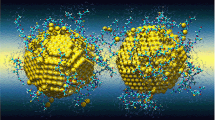Abstract
The molecular nanotechnology is the concept of functional mechanical system at the molecular scale, i.e., machines at the molecular scale, designed and built atom by atom. This idea along with self recognition (self assembly) can be used in the development of intelligent nanoparticles (NPs). In this paper we present a mathematical formalism of force balance and self assembly along with a quantum mechanical algorithmic approach for avoiding uncertainty relations in a limited range, where tiny nano particle (1–100 nm), constitute an elementary unit. We explain the natural self organization, where, the system organizes itself, but there is no known agent inside the system doing the organizing. Thiol, aspartic acid, citrate and bovine serum albumin capped gold NPs were synthesised in the laboratory with potentially useful size and shape dependent properties. We used colloidal method for synthesis of NPs confinement at 2, 5, 10 and 20 nm. The particle shape contours were measured by transmission electron microscope with high resolution field emission scanning electron microscope (FE-SEM, FEI Quanta 200F). AFM (AFM-STM, Ntegra Ts-150) study was performed to see the surface topology and confinement. SPR spectra study including pH stability analysis is used to study the properties of quantum confinement.






Similar content being viewed by others
References
K Drexler Eric Nanosystems Molecular Machinery, Manufacturing and Computation (New York: Wiley) (1992)
R P Feynman Eng. Sci. 23 22 (1960)
D Dutta Majumder, R Banerjee, C Ulrichs, I Mewis and A Goswami IETE Tech. Rev. 24 9 (2007)
M H P Reddy, A Sreedhar and S Uthanna Indian J. Phys. 86 291 (2012)
G Mandal and T Ganguly Indian J. Phys. 85 1229 (2011)
S Sarmah and A Kumar Indian J. Phys. 85 713 (2011)
B W Ninham and P Lo Nostro Molecular Forces and Self Assembly in Colloid, Nano Science and Biology (New York: Cambridge University Press) (2010)
B Amir Parviz and D Ryan IEEE Trans. Adv. Packag. 26 233 (2003)
W Heisenberg The Physical Principles of the Quantum Theory (Chicago: University of Chicago Press, Dover Publications) (1949)
S Roy, A Gogoi and G A Ahmed Indian J. Phys. 84 1405 (2010)
D Sajan, T Kuruvilla, K P Laladhas and I Hubert Joe Indian J. Phys. 85 477 (2011)
A U Ubale and A N Bargal Indian J. Phys. 84 1497 (2010)
P A M Dirac Principles of Quantum Mechanics (USA: Oxford University Press) (1932)
V K Wadhawan Smart Structures Blurring the Distinction Between the Living and the Nonliving (USA: Oxford University Press) (2007)
R J Williams, A M Smith, R Collins, N Hodson, A K Das and R V Ulijn Nature 4 19 (2009)
P Alexandridis and B Lindman Amphiphilic Block Copolymers: Self assembly and Applications (Amsterdam: Elsevier) (2000)
H Zhang J. Phys. Chem. B 107 13051 (2003)
N Dutta Gupta, K R Sahu, I Das, A De and U De Indian J. Phys. 84 1413 (2010)
D Dutta Majumder Kybernetes 8 7 (1979)
S K Pal and D Dutta Majumder Fuzzy Mathematical Approach to Pattern Recognition (New York: Wiley) (1986)
D Dutta Majumder and K K Majumdar Kybernetes 33 1143 (2004)
W Heisenberg The World of Physics (ed.) J H Weaver (New York: Simon and Schuster) p 353 (1986)
W Heisenberg The World of Physics (ed.) J H Weaver (New York: Simon and Schuster) p 397 (1986)
S K Dutta Phys. Essays 8 4 (1995)
D Dutta Majumder and S K Dutta Kybernetes 36 754 (2007)
D P Gogoi, G A Ahmed, D Mohanta, A Choudhury and G A Stanciu Indian J. Phys. 84 1361 (2010)
S Mitra, A Mandal, S Banerjee, A Datta, S Bhattacharya, A Bose and D Chakravorty Indian J. Phys. 85 649 (2011)
Acknowledgments
The authors wish to acknowledge with thanks to all engineers and staff of Institute of Cybernetics Systems and Information Technology (ICSIT), all our colleagues at the Biological Science Division, Indian Statistical Institute, Kolkata, ECSU, Indian Statistical Institute, Kolkata and Department of Radio physics and Electronics, Calcutta University, Kolkata.
Author information
Authors and Affiliations
Corresponding author
Rights and permissions
About this article
Cite this article
Karan, S., Dutta Majumder, D. & Goswami, A. A mathematical formalism of self assembly for design and fabrication of nanostructured materials: a new paradigm for nanotechnology. Indian J Phys 86, 667–676 (2012). https://doi.org/10.1007/s12648-012-0125-z
Received:
Accepted:
Published:
Issue Date:
DOI: https://doi.org/10.1007/s12648-012-0125-z




